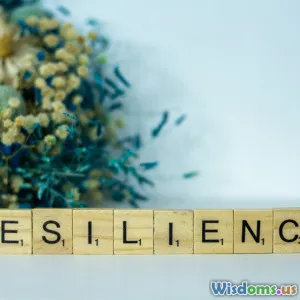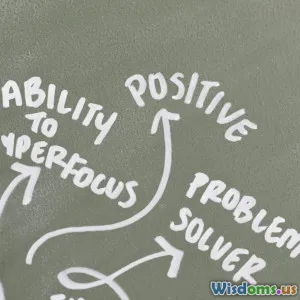
Seven Secrets to Bouncing Back Stronger After Failure
11 min read Discover seven proven strategies to turn failure into opportunity and emerge stronger than ever before. (0 Reviews)
Seven Secrets to Bouncing Back Stronger After Failure
Failure is an inevitable part of life, but it's rarely the end of the story. In fact, some of the world's most successful people have reached their pinnacles precisely because they learned how to rise after setbacks. Understanding how to transform defeat into renewed strength is a critical skill, whether you're navigating your career, personal relationships, or creative pursuits. Here are seven powerful secrets, grounded in research, psychology, and real-world examples, that will help you not only recover from failure—but come back even stronger.
Reframe Setbacks as Learning Opportunities

The first secret to rebounding from failure is adjusting your perspective. Rather than seeing setbacks as dead ends, successful people perceive them as essential learning moments. Behavioral psychologists refer to this mindset shift as adopting a "growth mindset"—the belief that abilities and intelligence can be developed through effort and perseverance.
Example: After being demoted from his first job at a newspaper, Walt Disney could have accepted failure. Instead, he used the experience to hone his creative vision and resilience, eventually founding one of the most influential media empires in history.
How to reframe your setback:
- Ask yourself what specifically went wrong, and what external factors (not just personal shortcomings) contributed.
- Identify at least three things you learned from the experience, even if they're uncomfortable. For example, an entrepreneur who launches a product that flops might discover valuable insights about customer preferences or flaws in their marketing approach.
- Share your lessons with others—it reinforces your learning and can foster a sense of constructive progress.
Practice Self-Compassion, Not Self-Blame

Failure can sting, but harsh self-criticism only compounds the pain. Recent studies, such as those published in the journal Self and Identity, show that self-compassion—not self-doubt—enables individuals to recover emotionally and stay motivated after falling short of their goals.
Insight: Dr. Kristin Neff, a pioneering researcher in self-compassion, emphasizes treating yourself with the same kindness you would offer a friend facing a similar disappointment. Dwell briefly on your feelings, but resist the urge to ruminate and punish yourself. Doing so shortens recovery time and prepares your mind for growth.
Tips:
- Replace the phrase "I failed" with "Something I attempted failed"—this separates your identity from the outcome.
- Write a supportive letter to yourself outlining how you’d encourage someone else in your shoes.
- Try a brief mindfulness meditation to acknowledge your emotions without judgment, then let them pass.
Adopt a Solutions-Focused Mindset

Resilient individuals don't dwell on the problem—they look for actionable solutions. Analysis by the Harvard Business Review highlights that "solution-oriented" thinking is a key trait among high-performing leaders.
Analysis: After SpaceX’s early rocket launches failed spectacularly, Elon Musk and his engineers convened post-mortem sessions to pinpoint tiny design flaws and procedural gaps. This relentless solutions focus was instrumental in achieving future launches.
How to develop this mindset:
- After a failure, conduct a quick SWOT analysis (Strengths, Weaknesses, Opportunities, Threats) on your actions and decisions.
- Create a list of small, immediate steps that could lead to progress. For instance, if you didn’t get a job you wanted, revamp your resume, seek targeted feedback, or sign up for a relevant workshop.
- Surround yourself with people who propose ideas, not just dwell on the issues.
Set Clear, Incremental Goals for Recovery

When facing failure, the mountain of returning to "success" can seem insurmountable. One proven approach is breaking down big ambitions into clear, actionable steps. According to psychologist Dr. Edwin Locke, setting specific goals increases motivation and the likelihood of achievement—especially after adversity.
How-to Example: Suppose your tech startup collapses after two years. Instead of aiming immediately for "success again," create measurable—and realistic—targets: rewrite your business plan, consult with five mentors in a month, and launch a minimal viable product (MVP) within the next quarter.
Actionable advice:
- Use the SMART framework (Specific, Measurable, Achievable, Relevant, Time-Bound) to structure your new goals.
- Track achievements in a journal or digital tool, appreciating small wins as signals of progress.
- Celebrate milestones, even minor ones—it rebuilds motivation and self-trust.
Cultivate a Strong Support Network

Isolation deepens the wounds of failure. Conversely, a strong network helps us process our experiences and regain confidence. From peer-oriented masterminds to supportive family members, relationships matter.
Example: When J.K. Rowling received multiple rejections for "Harry Potter and the Philosopher’s Stone," her friends and loved ones provided encouragement to keep submitting her manuscript. Today, she’s among the best-selling authors in history—a testament to the role of community in recovery.
Advice:
- Seek feedback from mentors or colleagues who can offer constructive critiques without judgment.
- Don’t hesitate to share your setback with trusted friends or support groups; vulnerability often leads to deeper connections.
- Consider joining online forums or local meetups related to your field for emotional reinforcement and advice.
Analyze and Reverse-Engineer the Failure

Deeply successful people treat failure almost as a puzzle. Analytical post-mortems can reveal key variables or systemic flaws, preventing similar missteps in the future.
Example: After the failed Mars Climate Orbiter mission in 1999, NASA found that a units conversion error (imperial vs. metric) led to disaster. The agency responded not with blame, but systematic reviews and improved protocols, resulting in more reliable missions down the line.
How to reverse-engineer your failures:
- Collect all the facts surrounding the outcome, maintaining objectivity (data, timing, resources).
- Interview people involved (even if it’s just yourself; an honest, self-questioning process is vital).
- Map each action or decision that led to failure. Look for patterns—do you repeatedly miss deadlines, overlook details, or fail to ask for help?
- Turn your findings into standard procedures or lessons learned documents.
Remain Persistent—and Open to Redirection

Thomas Edison famously said, "I have not failed. I've just found 10,000 ways that won't work." Persistence is essential, but it’s equally crucial to know when to pivot your approach or redefine your goals.
Comparison: Consider athletes recovering from major injury. Some, like tennis champion Monica Seles, return to their sport after intense rehabilitation. Others, such as Bethany Hamilton—who lost her arm in a shark attack—find new techniques and adapt to changed circumstances, becoming stronger by embracing redirection.
Tips for balanced persistence:
- Regularly revisit your objectives; sometimes the destination needs adjusting after failure exposes new realities.
- Set boundaries for when it’s wise to walk away versus push forward. Consult advisors with broader perspective to avoid costly tunnel vision.
- Document your progress. Many paths to success are non-linear. Looking back on your incremental advances can reveal just how resilient you’ve been.
Failure need not be an endpoint—it is, more often than not, a fork in the road leading to greater discoveries about your strengths, adaptability, and the world around you. Embrace these seven secrets the next time you stumble, and you’ll find yourself not only recovering, but thriving, stronger and more capable than before.
Rate the Post
User Reviews
Popular Posts




















